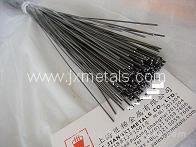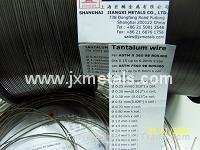Model No.︰TA9995-F560
Brand Name︰jxmetals
Country of Origin︰-
Unit Price︰-
Minimum Order︰-
Material : Biomedical Tantalum wire for surgical implants
Specifications : according to ASTM F 560 or ISO 5832-3. The recognized standard by The Food and Drug Administration (FDA) is ASTM F560-98, which is the Standard Specification for Unalloyed Tantalum for Surgical Implant Applications.
Size available : Diameter 0.15 up to 2.50mm x coil (at random length).
Typical application : tantalum wire can be used the orthopedic medical devices such as, Posterior Thoracolumbar Fixation System,
Cervical Fixation System, SmartLoc Spinal Fixation System;tantalum wire can be headed into tantalum ball or tantalum bead through cut of in the heading machine, then after flashing, grinding process to get the finished tantalum balls or tantalum beads; another shape is tantalum pin, cut and machined from rolls of tantalum wire ASTM F560, these medical grade of tantalum pins, tantalum balls, tantalum spheres and tantalum beads are used as tantalum wire markers or tantalum markers.
ASTM F 560 medecal grade Tantalum wire stents provide excellent radiopacity, flexibility, and structural support.
Medical grade Tantalum has been widely used in surgical applications such:
- in fracture repair;
- in dental applications;
- as a flexible stent to prevent arterial collapse;
- as a stent to treat biliary and arteriovenous (haemodialyzer) fistular stenosis;
- tantalum wire markers for improving x-ray radiopacity in implant applications.
- as a radiographic marker for diagnostic purposes, due its high density;
- as vascular clips, with the particular advantage that since tantalum is not
ferromagnetic it is highly suited to MRI scanning;
- as the material of choice for permanent implantation in bone contributing to
its excellent biocompatibility, as osteomigration prevents migration;
|
Unit Weight | |||
| Temper Condition: Annealed or full Hard at buyer's option | KG/M | |||
| SIZE IN INCH | SIZE IN MM | |||
| ø0.18MM(±0.013) X LENGTH | 0.000424 | |||
| ø .008" (±.005") x LENGTH | ø0.20MM(±0.013) X LENGTH | 0.000523 | ||
| ø .010" (±.005") x LENGTH | ø0.25MM(±0.013) X LENGTH | 0.000817 | ||
| ø .012" (±.005") x LENGTH | ø0.30MM(±0.013) X LENGTH | 0.001177 | ||
| ø .020" (±.005") x LENGTH | ø0.50MM(±0.013) X LENGTH | 0.003269 | ||
| ø0.60MM(±0.019) X LENGTH | 0.004708 | |||
| ø .025" (±.00075") x LENGTH | ø0.635MM(±0.019) X LENGTH | 0.005273 | ||
| ø0.70MM(±0.025) X LENGTH | 0.006408 | |||
| ø0.80MM(±0.025) X LENGTH | 0.008369 | |||
| ø .035" (±.0010") x LENGTH | ø0.889MM(±0.025) X LENGTH | 0.010335 | ||
| ø0.90MM(±0.025) X LENGTH | 0.010592 | |||
| ø1.0MM(±0.025) X LENGTH | 0.013077 | |||
| ø .059" (±.0010") x LENGTH | ø1.5M(±0.025) X LENGTH | 0.029423 | ||
| ø .061" (±.0015") x LENGTH | ø1.55M(±0.038) X LENGTH | 0.031417 | ||
| ø .063" (±.0015") x LENGTH | ø1.60M(±0.038) X LENGTH | 0.033477 | ||
| ø .065" (±.0015") x LENGTH | ø1.65M(±0.038) X LENGTH | 0.035602 | ||
| ø .080" (±.0015") x LENGTH | ø2.0M(±0.038) X LENGTH | 0.052307 | ||
| ø .093" (±.0020")x LENGTH | ø2.36M(±0.051) X LENGTH | 0.072833 | ||
| ø3.0M(±0.051) X LENGTH | 0.117692 | |||
Tantalum markers in radiography:
Tantalum pin markers (99.9% purity) and tantalum spherical markers (99.95% purity) were evaluated well on the biocompatibility.
Tantalum markers in radiography with tantalum pin and tantalum spherical markers being implanted into bony and soft tissues of human beings, No macroscopic reaction was noted around the markers, those implanted into bone were firmly fixed exhibiting close contact with adjacent bone lamellae. Tantalum beads (or tantalum balls or tantalum spheres) imbedded in the anterior and posterior edges of the implant allow for x-ray confirmation of implant location. The tantalum marker beads allow radiographic location and orientation of the implant . Tantalum pellets are used as X-ray markers because of their excellent radiopaque characteristics and biocompatability.
Tantalum markers in spine surgery (spinal implants) :
X-ray markers allow for an optimal final positioning of both cages and an easy radiological assessment, also post-operatively to follow-up an eventual migration. The right and left cage can be easily identified due to the special alignment of the x-ray markers.
Tantalum markers facilitate intraoperative positioning and follow-up of the PBVR;
Tantalum wire markers (ASTM F 560 or ISO 5832-3) are inserted into components to give surgeons a visual aid in determining the location of the spinal implant , both inter and post-operatively. The device comes in various sizes and is offered in both straight and tapered styles.
As the orthopedic material, fascia with Tantalum wire support by means of the implanted tantalum wire.
Tantalum structures for cancellous bone implants:
Unlike the elastic modulus of titanium ranges from 90 to 110 GPa, which is much higher than that of the bone (10 to 30 GPa), nearly five times that of bone, this stiffness can cause a stress shielding effect on the bone leading to osteoporosis, however the elastic modulus of tantalum is 3 Gpa, which is more similar to that of bone, i.e. tantalum has an elastic modulus close to that of bone, much closer than any of the other high-strength metals and alloys commonly used for implant; this too may well contribute to the favorable reaction with bone. With its greater ductility, excellent corrosion resistance, good workability, and demonstrated biocompatibility, tantalum clearly can be regarded as an excellent alternative to the metals and alloys presently in use and under development for bone implants.
Tantalum metal combines high strength and good ductility, making itself attractive candidate materials for implants (and effectively the most suitable for load-bearing applications). Many dental and orthopedic implants contain metal, most often ASTM F560 grade of tantalum, titanium and various alloys such as stainless steel or vitallium (cobalt-chromium-molybdenum). Ceramic-coated metals are also used, typically HA or TCP on titanium. Additionally, a large variety of tantalum metal is used internally in biomedical components such as tantalum wire, tantalum tubing(tantalum capillary), and tantalum radiopaque markers.
Many existing metallic biomaterials, however, do not easily lend themselves to fabrication into the porous structures that are most desirable for bone implants. These materials (e.g. stainless steel, cobalt-based alloys) exhibit the necessary properties and biocompatibility as long as only a smooth, bulk shape in a metallurgically perfect state is needed. The machining or other treatment needed to obtain a porous or surface-textured shape for interlocking with skeletal tissue can have a detrimental effect on the properties and biocompatibility, and can even result in material failure. For example, the hexagonal crystal structure of titanium makes it susceptible to cracks and fractures, as has been seen in the case of dental implants. Some porous metallic materials (e.g. flame- or plasma-sprayed titanium, porous sintered powder metallurgy materials) do not match the structure of cancellous bone sufficiently well to ensure successful ingrowth and integration. Also, most metals and alloys currently in use are subject to some degree of corrosion in a biological environment. Finally, the high densities of metals can make them undesirable from a weight standpoint.
|
Mechanical Properties of Trabecular Metal Compared With Those of Other Materials |
||||||
|
Mechanical Property |
TM (Tantalum) |
Cancellous Bone |
Cortical Bone |
Titanium |
Cobalt Chromium |
Stainless Steel |
|
Modulus of elasticity(GPa) |
2.5-3.9 |
6.8 |
13-17 |
106-115 |
210 |
230 |
|
Ultimate strength(MPa) |
50-110 |
10.4 |
48 |
780-1050 |
430-1028 |
480-860 |
|
Yield strength(MPa) |
35-51 |
5.1 |
N/A |
860 |
827 |
170-690 |
|
Compressive strength(MPa) |
50-70 |
N/A |
131-205 |
N/A |
N/A |
N/A |
|
Tensile strength(MPa) |
63 |
N/A |
53 |
N/A |
N/A |
N/A |
|
Bending strength(MPa) |
110 |
N/A |
N/A |
N/A |
N/A |
N/A |
|
Static torsional strength(MPa) |
40-60 |
N/A |
N/A |
N/A |
N/A |
N/A |
|
Endurance limit (10 million cycles in 4-point bending) |
18-20 |
N/A |
N/A |
N/A |
N/A |
N/A |
|
GPa = gigapascal, MPa = megapascal, N/A = not available, TM = Trabecular Metal |
||||||
ASTM F560 grade Tantalum is an excellent medical metal materials having good biocompatibility and anti-corrosive physiology. Implantation of bone and the surrounding tantalum can form new bone combination. Soft tissue implants, muscle and other organizations may be dependent on the tantalum normal growth in the human body to stimulate and toxicity. Biomedical tantalum can be used as bone fracture plate, skull plates and bone screws, planted roots, maxillofacial restoration, and the denture and surgical suture needle. Tantalum unique surface negative electric charge it has excellent anti-thrombosis capacity for vascular stents and for the artificial heart.
Tantalum radiopaque markers have tantalum wire, tantalum ribbon, tantalum sheet, tantalum foil, tantalum capillary tube, tantalum cut tube(the radiopaque markers for stents), tantalum bead, tantalum ball, tantalum pellet, tantalum pin, etc.,
Trade name: tantalum pin, tantalum pin manufacturers, tantalum pin implants, tantalum pin connections, tantalum pin markers, tantalum wire marker, tantalum tubing marker, tantalum capillary marker, tantalum capillary tube marker, tantalum wire markers, tantalum tube marker, tuantalum tubing markers, tantalum capillary markers, tantalum capillary tube markers, tantalum tube markers, tantalum pins for use in the radiological positioning of a medical device, tantalum stud, tantalum studs, tantalum markers in radiography, tantalum skeletal radiographic markers, tantalum soft tissue radiographic markers, tantalum solids, tantalum solid, tantalum pins as skeletal markers, glass-sealed tantalum pins used as input/output connections, tantalum anodes, tantalum anode, tantalum wire per ISO 13782 -Implants for surgery -- Metallic materials -- Unalloyed tantalum for surgical implant applications, tantalum medical devices in conformity with ISO 13485 quality management system, the radiopaque filaments, the radiopaque filament, medical metal, medical metals, medical alloy, medical alloys, tantalum implant, bone implant, ortho implant, precision tantalum wire, ta wire, ta wires, precision tantalum wires, tantalum fine wires, tantalum fine wire, ta fine wires, ta fine wire, ta precision wire, ta precision wires, tantal wire, tantalum metals surgical implants, surgical implants tantalum metal, orthopaedic medical devices, medical wire, medical tantalum wire, surgical tantalum wire, medical grade tantalum wire, medical grade wire, tantalum marker pin wire, tantalum marker wires, tantalum marker pins, etc.,
Standard Specification for Unalloyed Tantalum for Surgical Implant Applications (ASTM F 560 - 05 UNS R05200, ASTM F 560 - 05 UNS R05400). This specification is under the jurisdiction of ASTM committee F04 on Medical and Surgical Materials and Devices (orthopaedic medical devices) and is the direct responsibility of Subcommittee F04.12 on Metallurgical Materials.
This Specification covers the chemical requirements, mechanical properties, and metallurgical requirements for unalloyed tantalum wire, unalloyed tantalum rod, unalloyed tantalum tube, unalloyed tantalum ribbon, unalloyed tantalum strip, unalloyed tantalum foil, unalloyed tantalum sheet, unalloyed tantalum plate, etc., used in the manufacture of surgical implants.
Referenced Standards :
ASTM B 364 Specification for Tantalum and Tantalum Alloy Ingots;
ASTM B 365 Specification for Tantalum rod + Tantalum Alloy Rod + Tantalum Wire +
Tantalum Alloy Wire;
ASTM B 708 Specification for Tantalum Ribbon, Tantalum Alloy Ribbon, Tantalum Strip, Tantalum Alloy Strip, Tantalum Foil, Tantalum Alloy Foil, Tantalum Sheet, Tantalum Alloy Sheet, Tantalum Plate, Tantalum Alloy Plate;
ASTM E 8 Test Methods for Tension Testing of Metallic Materials;
ASTM E 29 Practice for Using Significant Digits in Test Data to Determine Conformance with Specifications;
ASTM F 981 Practice for Assessment of Compatibility of Biomaterials for Surgical Implants with Respect to Effect of Materials on Muscle and Bone;
ASQ C1 Specification of General Requirements for a Quality Program;
ISO 6892 Metallic Materials Tensile Testing at Ambient Temperature;



